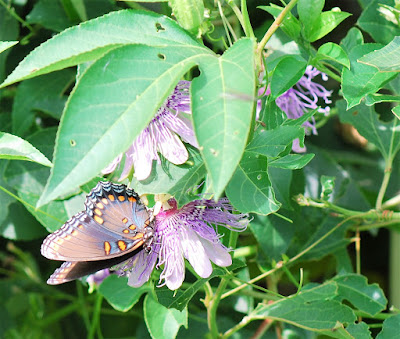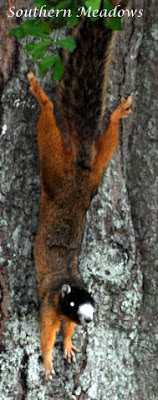August Garden Blooms & Pollinators
Heat and humidity get kicked up a notch in August, making it tough for any serious gardening. But getting outside is rewarding when there are so many butterflies, hummingbirds, lizards, birds and other insects to distract from the sweat, fire ant bites and mosquitoes. It's Garden Bloggers' Bloom Day, hosted by May Dreams Gardens. Follow the link to see what others are sharing.
Here are the blooms that are carrying our garden through the end of summer and supporting all that wildlife.
Starting on the south side of our house, the spectacular Susan's hug visitors who make their way to the front door. Partnered with pink and purple Mexican petunias (Rueilla) and [still blooming] butterfly weed (Asclepias tuberosa), it is a hang out for bees, butterflies and hummers.
Also, in this bed is spring blooming, golden alexander that is hosting black swallowtail caterpillars this time of year.
The distinctive blooms of Passiflora incarnata, are a great nectar source for bees and butterflies and a foliage is a buffet for variegated and gulf fritillary caterpillars. Be sure to visit again soon as I have an upcoming post on this native vine.
The towering liatris spicata and willowy coreopsis are dangling over the stairs that wrap around the front of the house requiring a little choreography to get around these perfect pollinator plants. You can read more about the liatris show and all the butterflies and bees it attracts on my previous post here.
It's a tough world out there for insects. As much as we enjoy watching the butterflies, they are food for others. This poor lady looks like she almost fell prey to a bird and lost her tails.
I have to brag on the Joe Pye Weed (Eutrochium purpureum). It stands tall at the woodland edge and is covered in swallowtail butterflies. It is a spectacular show.
Yesterday I counted over 40 Eastern Tiger Swallowtails and they keep coming! This JPW is planted near one of their host plants, tulip poplar trees (Liriodendron tulipifera L.). I like to think that they don't have to travel far to find food for their different lifecycle stages.
In the same bed are other tall (up to 7 feet!) wildflowers that share similar growing conditions; 'Henry Eilers Rudbeckia subtomentosa and tall ironweed (Vernonia gigantea). The buttery yellow blooms on this rudbeckia make an unique edition to this planting trio.
The deep purple of the tall ironweed is a favorite late summer flower for long-tongued bees, skipper butterflies and bee flies. This has just come into bloom and will continue into September.
Lastly, I want to share cardinal flower (Lobelia cardinalis). The tall spikes of our plant flopped over during our period of drought in July. Interestingly, the fallen spikes put out multiple stems providing even more shorter bright blooms. The red tubular flowers are loved by the hummers and cloudless sulphur butterflies.
Hope you enjoyed a look at our late summer garden. I appreciate you stopping by.












